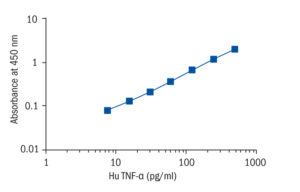TNF-alpha Human ELISA
Tumor Necrosis Factor alpha (TNF alpha), also known as cachectin, is a polypeptide cytokine produced by monocytes and macrophages. It functions as a multipotent modulator of immune response and further acts as a potent pyrogen. TNF alpha circulates throughout the body responding to stimuli (infectious agents or tissue injury), activating neutrophils, altering the properties of vascular endothelial cells, regulating metabolic activities of other tissues, as well as exhibiting tumoricidal activity by inducing localized blood clotting. TNF alpha also inhibits lipoprotein lipase activity resulting in cachexia, a physical wasting condition. Activation of B-cells by the Epstein Barr virus can be inhibited by TNF alpha. Due to its varied actions throughout the immune system, TNF alpha may play a role in the pathogenesis of many disease states.
TNF alpha production is mediated by the action of lymphokines and endotoxins on the macrophage. Purified monocytes produce TNF alpha within four hours of stimulation by recombinant IL-2 and there is some in vitro evidence to suggest that TNF alpha is expressed at high levels and with prolonged kinetics in T cells stimulated by both CD2 and CD28. Secretion of TNF alpha is enhanced by gamma interferon. TNF then induces or enhances the specific production of Class I MHC antigen, GM-CSF, and IL-1. Recent evidence has suggested an intracellular role for this peptide.
TNF alpha may play a significant role in the pathogenesis of inflammatory disease of the joints and other tissues. Chin et al. found that TNF alpha, along with gamma interferon and IL-1 increased cell surface expression of ICAM-1 on synovial fibroblasts. Alvaro-Garcia et al. report that TNF alpha stimulates synovial proliferation. Waage et al. found that increased levels of TNF alpha in patients with septicemia and meningococcal disease correlated with fatal outcome. Scuderi et al. suggest that increased levels of this cytokine may play a role in the host defense mechanism against parasitic infections. Girardin et al. reported that increased serum TNF alpha levels correlated with the number of risk factors involved in children with gram-negative sepsis and purpura fulminians. Elevated levels of TNF alpha were also found in individuals suffering from myocarditis.
Recently, a growing body of information has pointed to a role for TNF alpha in the pathogenesis of AIDS. Alveolar macrophages (AM) from HIV positive individuals with opportunistic lung infections have been shown to spontaneously produce higher levels of TNF alpha in vitro than those HIV positive individuals without infection and HIV negative controls. Krishnan et al report that higher TNF alpha production by AM was associated with lower counts of pneumocystis carinii in broncheoalveolar lavage fluid, indicating that TNF alpha may play a role in the control of this infection in AIDS. Israel-Biet et al. also reported in in vitro studies, that AM that express HIV(p24+) released significantly higher levels of TNF alpha than p24- alveolar macrophages and controls. Reddy et al. found persistently elevated levels of circulating TNF alpha in HIV seropositive individuals and suggest a possible involvement of this cytokine in the development of AIDS.
Measurement of TNF alpha levels has also been shown to be useful in transplant research, where Maury et al. and McLaughlin et al.. both reported TNF alpha to be markedly elevated in renal allograft rejection episodes. Recent evidence has been presented on increased TNF alpha levels in Bone Marrow Transplant (BMT) BMT patients with major transplant related complications such as interstitial pneumonitis and severe acute graft-versus-host disease had TNF alpha levels significantly increase over controls.
Research topic
Cytokines and chemokines and related molecules, Energy metabolism and body weight regulation
Type
Sandwich ELISA, Biotin-labelled antibody
Applications
Serum, Plasma-EDTA, Plasma-Heparin, Plasma-Citrate, Urine, Body fluids, Culture medium
Sample Requirements
50 µl/well
Storage/Expiration
Store the complete kit at 2–8°C. Under these conditions, the kit is stable until the expiration date (see label on the box).
Calibration Curve

Calibration Range
7.8–500 pg/ml
Limit of Detection
2.3 pg/ml
Intra-assay (Within-Run)
CV = 6.0%
Inter-assay (Run-to-Run)
CV = 7.4%
Spiking Recovery
93,00%
Dilutation Linearity
105,00%
– Bugianesi E, Bizzarri C, Rosso C, Mosca A, Panera N, Veraldi S, Dotta A, Giannone G, Raponi M, Cappa M, Alisi A, Nobili V. Low Birthweight Increases the Likelihood of Severe Steatosis in Pediatric Non-Alcoholic Fatty Liver Disease. Am J Gastroenterol. 2017 May 30. doi: 10.1038/ajg.2017.140. [Epub ahead of print] PubMed PMID: 28555633.
– Emanuela V, Pina MM, Lillà L, Gina C, Giovanna T, Chiara DF, Sergio C, Marcello G, Antonio V, Bruno DL, Marianna C, Marcellino M. Effects Of An High-Fat Diet Enriched In Lard Or In Fish Oil On The Hypothalamic Amp-Activated Protein Kinase And Inflammatory Mediators. Frontiers in Cellular Neurosci. 9.6.2016;10 (00150)
– Kim YC, Cho YK, Lee WY, Kim HJ, Park JH, Park DI, Sohn CI, Jeon WK, Kim BI, Park SE, Rhee EJ, Park CY, Oh KW, Park SW, Kim SW, Ryu SH. Serum adipocyte-specific fatty acid-binding protein is associated with nonalcoholic fatty liver disease in apparently healthy subjects. J Nutr Biochem. 2011 Mar;22 (3):289-92
– Scuruchi M, D’Ascola A, Avenoso A, Campana S, Abusamra YA, Spina E, Calatroni A, Campo GM, Campo S. 6-Mer Hyaluronan Oligosaccharides Modulate Neuroinflammation and Alpha Synuclein Expression in Neuron-Like SH-SY5Y Cells. J Cell Biochem. 2016 May 11;
– Tsigou E, Stavros A, Pavlos M, Stavros G, Athanassios T, George B. The immune response after stimulation with wall components of gram-positive bacteria and fungi. Immunol Lett. 2014 May-Jun;159 (1-2):23-9

